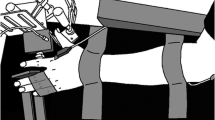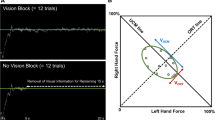Abstract
Purpose
Previous research has indicated that older adults have significantly lower accuracy in terms of force control than young adults. In addition, accuracy of force control is known to decrease in the absence of visual feedback. However, whether the effect of visual feedback on fine motor control is similar for young adults and older adults is not clear. The purpose of this study, therefore, was to examine the effect of visual feedback on bimanual pinch force control in older adults.
Methods
Thirty-one undergraduate students (age 19.7 ± 0.9 years) and 31 older adults (age 65.1 ± 8.1 years) participated in this study. After measuring finger-pinch maximal voluntary force (MVF), the participants were asked to maintain 10 % MVF as steadily as possible in two different conditions: with visual feedback (visual feedback condition; VF condition) and without visual feedback (no visual feedback condition; NVF condition).
Results
We found that older adults had significantly greater targeting error and force variability than young adults in the VF condition, but not in the NVF condition. In addition, older participants exhibited a significantly greater sum of power for the 0–4 and 4–8 Hz frequency bin than young adults (p < 0.05) in the VF condition, although there was no significant difference in the NVF condition.
Conclusions
These results suggest that older adults do not use visual information as effectively as younger adults to reduce force control error.




Similar content being viewed by others
Abbreviations
- ANOVA:
-
Analysis of variance
- CV:
-
Coefficients of variance
- MVF:
-
Maximal voluntary force
- NVF:
-
No visual feedback
- RMSE:
-
Root mean square error
- VF:
-
Visual feedback
References
Baweja HS, Patel BK, Martinkewiz JD, Vu J, Christou EA (2009) Removal of visual feedback alters muscle activity and reduces force variability during constant isometric contractions. Exp Brain Res (Experimentelle Hirnforschung Experimentation cerebrale) 197(1):35–47. doi:10.1007/s00221-009-1883-5
Baweja HS, Kennedy DM, Vu J, Vaillancourt DE, Christou EA (2010) Greater amount of visual feedback decreases force variability by reducing force oscillations from 0–1 and 3–7 Hz. Eur J Appl Physiol 108(5):935–943. doi:10.1007/s00421-009-1301-5
Carmeli E, Patish H, Coleman R (2003) The aging hand. J Gerontol Ser A, Biol Sci and Med Sci 58(2):146–152
Christou EA (2005) Visual feedback attenuates force fluctuations induced by a stressor. Med Sci Sports Exerc 37(12):2126–2133
Deutsch KM, Newell KM (2001) Age differences in noise and variability of isometric force production. J Exp Child Psychol 80(4):392–408. doi:10.1006/jecp.2001.2642
Deutsch KM, Newell KM (2002) Children’s coordination of force output in a pinch grip task. Dev Psychobiol 41(3):253–264. doi:10.1002/dev.10051
Fox EJ, Baweja HS, Kim C, Kennedy DM, Vaillancourt DE, Christou EA (2013) Modulation of force below 1 Hz: age-associated differences and the effect of magnified visual feedback. PLoS One 8(2):e55970. doi:10.1371/journal.pone.0055970
Francis KL, Spirduso WW (2000) Age differences in the expression of manual asymmetry. Exp Aging Res 26(2):169–180. doi:10.1080/036107300243632
Freund HJ, Hefter H (1993) The role of basal ganglia in rhythmic movement. Adv Neurol 60:88–92
Grassi B, Cerretelli P, Narici MV, Marconi C (1991) Peak anaerobic power in master athletes. Eur J Appl Physiol Occup Physiol 62(6):394–399
Griffin L, Painter PE, Wadhwa A, Spirduso WW (2009) Motor unit firing variability and synchronization during short-term light-load training in older adults. Exp Brain Res Experimentelle Hirnforschung Experimentation cerebrale 197(4):337–345. doi:10.1007/s00221-009-1920-4
Hackel ME, Wolfe GA, Bang SM, Canfield JS (1992) Changes in hand function in the aging adult as determined by the Jebsen Test of Hand Function. Phys Ther 72(5):373–377
Hu X, Newell KM (2011) Aging, visual information, and adaptation to task asymmetry in bimanual force coordination. J Appl Physiol 111(6):1671–1680. doi:10.1152/japplphysiol.00760.2011
Hu X, Loncharich M, Newell KM (2011) Visual information interacts with neuromuscular factors in the coordination of bimanual isometric force. Exp Brain Res (Experimentelle Hirnforschung Experimentation cerebrale) 209(1):129–138. doi:10.1007/s00221-010-2528-4
Hughes S, Gibbs J, Dunlop D, Edelman P, Singer R, Chang RW (1997) Predictors of decline in manual performance in older adults. J Am Geriatr Soc 45(8):905–910
Keen DA, Yue GH, Enoka RM (1994) Training-related enhancement in the control of motor output in elderly humans. J Appl Physiol 77(6):2648–2658
Kennedy DM, Christou EA (2011) Greater amount of visual information exacerbates force control in older adults during constant isometric contractions. Exp Brain Res Experimentelle Hirnforschung Experimentation cerebrale 213(4):351–361. doi:10.1007/s00221-011-2777-x
Keogh J, Morrison S, Barrett R (2006) Age-related differences in inter-digit coupling during finger pinching. Eur J Appl Physiol 97(1):76–88. doi:10.1007/s00421-006-0151-7
Kurt W. Kornatz EAC, Roger M. Enoka (2005) Practice reduces motor unit discharge variability in a hand muscle and improves manual dexterity in old adults. J Appl Physiol 98:2072–2080. doi:10.1152/japplphysiol.01149.2004.-A
Laidlaw DH, Kornatz KW, Keen DA, Suzuki S, Enoka RM (1999) Strength training improves the steadiness of slow lengthening contractions performed by old adults. J Appl Physiol 87(5):1786–1795
Marmon AR, Enoka RM (2010) Comparison of the influence of two stressors on steadiness during index finger abduction. Physiol Behav 99(4):515–520. doi:10.1016/j.physbeh.2010.01.002
Marmon AR, Gould JR, Enoka RM (2011) Practicing a functional task improves steadiness with hand muscles in older adults. Med Sci Sports Exerc 43(8):1531–1537. doi:10.1249/MSS.0b013e3182100439
Mauter G, Katzke S (2003) The Application of Operational Haptics in Automotive Engineering. Business Briefing: Global Automotive Manufacturing and Technology 2003, Team for Operational Haptics, Audi AG, pp 78–80
Ofori E, Samson JM, Sosnoff JJ (2010) Age-related differences in force variability and visual display. Exp Brain Res Experimentelle Hirnforschung Experimentation cerebrale 203(2):299–306. doi:10.1007/s00221-010-2229-z
Oldfield RC (1971) The assessment and analysis of handedness: the Edinburgh inventory. Neuropsychol 9:97–113
Patten C, Kamen G (2000) Adaptations in motor unit discharge activity with force control training in young and older human adults. Eur J Appl Physiol 83:128–143. doi:10.1007/s004210000271
Ranganathan VK, Siemionow V, Sahgal V, Liu JZ, Yue GH (2001) Skilled finger movement exercise improves hand function. J Gerontol Ser A, Biol Sci and Med Sci 56(8):M518–M522
Rantanen T, Guralnik JM, Foley D, Masaki K, Leveille S, Curb JD, White L (1999) Midlife hand grip strength as a predictor of old age disability. JAMA, J Am Med Assoc 281(6):558–560
Slifkin AB, Newell KM (2000) Variability and noise in continuous force production. J Mot Behav 32(2):141–150. doi:10.1080/00222890009601366
Sosnoff JJ, Newell KM (2011) Aging and motor variability: a test of the neural noise hypothesis. Exp Aging Res 37(4):377–397. doi:10.1080/0361073X.2011.590754
Sosnoff JJ, Jordan K, Newell KM (2005) Information and force level interact in regulating force output during two and three digit grip configurations. Exp Brain Res Experimentelle Hirnforschung Experimentation cerebrale 167(1):76–85. doi:10.1007/s00221-005-0009-y
Sperling L (1980) Evaluation of upper extremity function in 70-year-old men and women. Scand J Rehabil Med 12(4):139–144
Swanson AB, Hagert CG, Swanson GD (1983) Evaluation of impairment of hand function. J hand surgery 8(5 Pt 2):709–722
Tracy BL (2007) Visuomotor contribution to force variability in the plantarflexor and dorsiflexor muscles. Hum Mov Sci 26(6):796–807. doi:10.1016/j.humov.2007.07.001
Tracy BL, Maluf KS, Stephenson JL, Hunter SK, Enoka RM (2005) Variability of motor unit discharge and force fluctuations across a range of muscle forces in older adults. Muscle Nerve 32(4):533–540. doi:10.1002/mus.20392
Tracy BL, Dinenno DV, Jorgensen B, Welsh SJ (2007) Aging, visuomotor correction, and force fluctuations in large muscles. Med Sci Sports Exerc 39(3):469–479. doi:10.1249/mss.0b013e31802d3ad3
Vaillancourt DE, Newell KM (2003) Aging and the time and frequency structure of force output variability. J Appl Physiol (1985) 94(3):903–912. doi:10.1152/japplphysiol.00166.2002
Vaillancourt DE, Russell DM (2002) Temporal capacity of short-term visuomotor memory in continuous force production. Exp Brain Res Experimentelle Hirnforschung Experimentation cerebrale 145(3):275–285. doi:10.1007/s00221-002-1081-1
Author information
Authors and Affiliations
Corresponding author
Additional information
Communicated by Fausto Baldissera.
Rights and permissions
About this article
Cite this article
Critchley, K., Kokubu, M., Iemitsu, M. et al. Age-related differences in the availability of visual feedback during bimanual pinch. Eur J Appl Physiol 114, 1925–1932 (2014). https://doi.org/10.1007/s00421-014-2916-8
Received:
Accepted:
Published:
Issue Date:
DOI: https://doi.org/10.1007/s00421-014-2916-8




